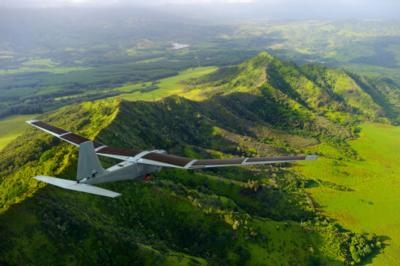Provides Manufacturers With A Simple Solution To Increase Endurance
Alta Devices and PowerOasis have announced they are partnering to develop the world’s first reference design for integrated solar and lithium-ion (Li-ion) battery power systems for small unmanned aerial vehicles (UAVs). By combining Alta Devices’ breakthrough solar technology with PowerOasis’ proven expertise in hybrid power systems, small UAV developers can focus on leveraging their core expertise in aircraft design and performance.

“In the past, a UAV manufacturer had to work with multiple companies to obtain the solar technology, downstream electronics, and power management software to create a solar/Li-ion hybrid powered system. Then, they had to design the system themselves,” said Alta Devices Chief Marketing Officer, Rich Kapusta. “By working together and providing a complete architecture for a well-crafted power system, PowerOasis and Alta Devices are streamlining the UAV development process. We are providing a complete system for electric aircraft and UAVs, eliminating the distraction and time required to focus on the intricacies of power design.”
An aircraft designer will be able to leverage this reference design to manage the complete energy generation, storage and power management system for a UAV. This is without having to bring this capability in-house, saving time and resources than can be better allocated to payload design and aircraft aerodynamics.
Many aircraft companies are turning to solar to provide added endurance to UAVs. A typical battery-powered UAV can normally stay aloft for only a few hours. With solar added to the wings, the same aircraft could fly all day. By combining the certainty of Li-ion battery power with the range and power extension of Alta Devices’ uniquely thin, flexible, and efficient solar cells, UAVs can now accomplish tasks that have not previously been possible. These include: infrastructure inspection over long distances, long range search and rescue operations, precision agriculture on industrial farms and communications infrastructure provisioning to underserved locations.
According to Pete Bishop, CTO of PowerOasis, “Up until now, it’s been nearly impossible to develop a hybrid solar/Li-ion UAV architecture for small aircraft because the solar technology compromised the design too severely. That is no longer true with Alta Devices’ solar technology.”
The reference architecture will target 2-4 meter (6.5-13 feet) span UAVs, using 5s-7s Li-ion batteries. Features include:
- High efficiency, light weight, modular power systems;
- Management of battery packs using a cell vendor agnostic, flexible battery management system (BMS);
- Communication to ground control and on-board autopilot with continuous real time power and energy data; and
- Conditioned power outputs for critical power and payload systems
The targeted release-date for the design is late 2017 and it will be available initially through Alta Devices and PowerOasis.
(Image provided with Alta Devices news release)
 ANN's Daily Aero-Linx (05.02.24)
ANN's Daily Aero-Linx (05.02.24) ANN's Daily Aero-Term (05.02.24): Touchdown Zone Lighting
ANN's Daily Aero-Term (05.02.24): Touchdown Zone Lighting Aero-News: Quote of the Day (05.02.24)
Aero-News: Quote of the Day (05.02.24) ANN FAQ: Contributing To Aero-TV
ANN FAQ: Contributing To Aero-TV NTSB Final Report: Cirrus Design Corp SR20
NTSB Final Report: Cirrus Design Corp SR20



